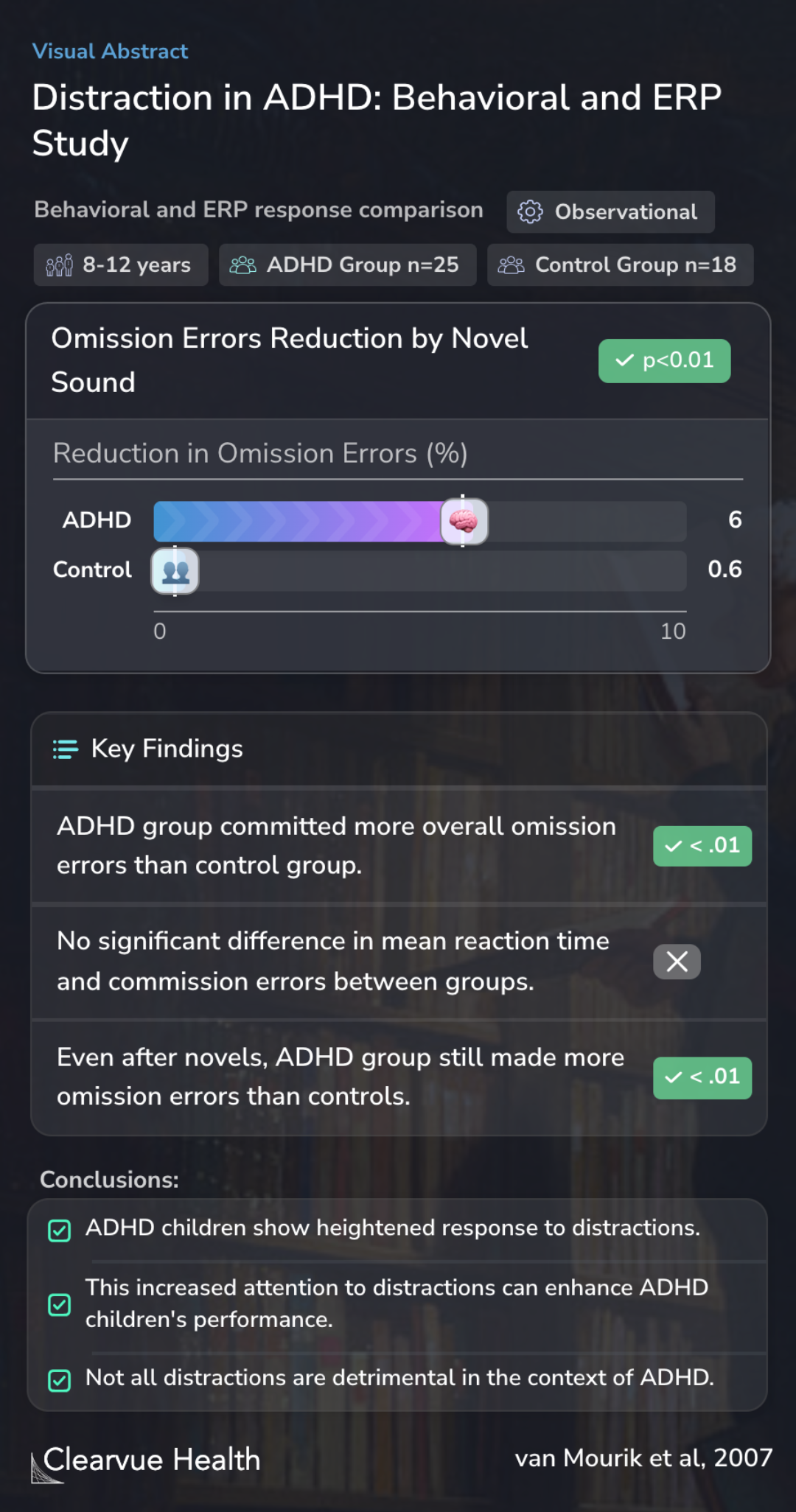When distraction is not distracting: a behavioral and ERP study on distraction in ADHD
Distraction in ADHD: Behavioral and ERP Study
Rosa van Mourik, Jaap Oosterlaan, Dirk J Heslenfeld, Claudia E Konig, Joseph A Sergeant

Objectives
The study primarily explores whether children diagnosed with Attention Deficit Hyperactivity Disorder (ADHD) are indeed more susceptible to distractions compared to their non-ADHD peers. This inquiry is vital since heightened distractibility is a critical behavioral criterion in ADHD diagnosis, yet empirical evidence in this area has been scant. This study seeks to fill that gap by examining the distractibility of children with ADHD in a structured setting.
Although an increased distractibility is one of the behavioral criteria of Attention Deficit Hyperactivity Disorder (ADHD), there is little empirical evidence that children with ADHD are in fact more distractible than their normal peers.
Methods
The research employed event-related potentials (ERPs) to measure the brain's response to distracting sounds. These sounds were categorized into two types: novel sounds (termed 'novels') and standard sounds. The study involved a group of twenty-five children diagnosed with ADHD and a comparison group of eighteen typically developing children, all aged between 8 and 12 years. Participants were engaged in a visual two-choice reaction time task during the ERP recording.
We recorded event-related potentials (ERPs) to distracting novel sounds (novels) and standard sounds, (standards) while children performed a visual two-choice reaction time task. Twenty-five children with ADHD were compared with eighteen normal controls (aged 8-12 years).
Results
The study's findings revealed a distinct pattern in the ADHD group's response to both types of sounds. A significant observation was the effect of novel sounds on the reduction of omission errors in the ADHD group, which was more pronounced than in the control group.
Children with ADHD showed a larger early P3a (150-250 ms), both in response to the standard and in response to the novel. The late phase of the P3a had a larger amplitude in the ADHD group in the 250-300 ms window compared to the control group, which was only present in response to the n...
Conclusions
The study concludes that while children with ADHD display an increased orienting response to novel stimuli, this heightened response can, under certain circumstances, enhance their performance. This improvement is possibly attributed to an optimal arousal level induced by the distraction, as evidenced by the reduced rate of omission errors. These findings suggest that not all forms of distraction have a detrimental impact on children with ADHD; instead, some can have beneficial effects.
Although children with ADHD show an increased orienting response to novels, this distracting information can enhance their performance temporarily, possibly by increasing their arousal to an optimal level, as indicated by the reduced omission rate. These data indicate that distraction is...
Context
This study adds to our understanding of how those with ADHD process distraction. For example, distraction and inattention have been shown to be at least partly responsible for slower reaction times in those with ADHD:
Interestingly, the study also highlights that ADHD individuals might derive more benefit from certain levels of noise or distraction. This finding adds a new dimension to our understanding of ADHD. Such insights are crucial, considering that ADHD is often associated with negative connotations. However, as research progresses, we're beginning to see a more nuanced picture, where certain aspects of ADHD, like impulsivity, might have positive applications, such as in entrepreneurship or academic settings.
Moreover, the study aligns with the ongoing exploration of effective treatments for ADHD. Medications like Strattera have shown promise in improving focus and reducing distractibility, underscoring the treatability of ADHD and highlighting the importance of tailored interventions.